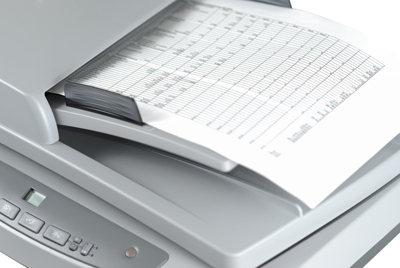If your organization is considering a paperless system, it is important to focus on each stage of the digitization process to ensure its completeness. Successful completion of the system greatly depends on the efficiency in producing true reproduction of your documents using a scanner. Document indexing is also as important as document scanning, which makes the scanned documents easily searchable.
A variety of document scanners (portable document scanners, desktop document scanner, etc) are available nowadays and to choose among them is really difficult. Here are some considerations that will help you identify a good scanner, ideal for your business — both from the software and hardware side.
Hardware Features to Consider When Selecting a Scanner
 Volume of Paper Documents: While selecting a scanner, consider its duty cycle that indicates the estimated volume of paper it can scan per day. For example, for some desktop scanners the duty cycle is 750 pages per day whereas for some others it is 4,000-plus pages per day. If the copies you are planning to scan per day are near to the end of their lifecycle, then it is better to seek the service of a document scanning company to get the scanning done. Otherwise, if the volume of paper to be scanned is low, you can go for a desktop scanner that suits your business needs.
Volume of Paper Documents: While selecting a scanner, consider its duty cycle that indicates the estimated volume of paper it can scan per day. For example, for some desktop scanners the duty cycle is 750 pages per day whereas for some others it is 4,000-plus pages per day. If the copies you are planning to scan per day are near to the end of their lifecycle, then it is better to seek the service of a document scanning company to get the scanning done. Otherwise, if the volume of paper to be scanned is low, you can go for a desktop scanner that suits your business needs.
Speed of the Scanner: Speed of the scanner is measured in terms of paper per minute (PPM). If the speed of the scanner is not satisfactory, then the result will be increased staff time and reduced efficiency. To avoid such a situation, you should first of all determine the volume of paper that needs to be scanned and then the range of speed required to deliver maximum throughput. Factors such as memory and CPU speed, and the type of interface connecting the scanner to your computer also determine the speed of the scanning machine.
Other Considerations: Consider other features that you prefer in the scanning machine for a smooth document scanning process. For example, if you want to scan black and white documents only, then you don’t need a color scanner. Check whether you need double-sided scanning, oversized-document scanning, file scanning or e-mail scanning. Certain other features such as color depth, optical resolution, and scanner software should also be considered while selecting a scanner.
Options for Converting a Scanned Document to a Searchable One
Precise versions of scanned documents are necessary for making them searchable and converting them into Word format, so that the content can be used in other documents. Prior to purchase, check whether the scanning software can perform document indexing and conversion.
Searchable PDF: A PDF file that includes text that can be searched using the standard ‘Adobe reader’ search functionality is referred to as ‘Searchable PDF’. This is one of the most commonly used formats and contains both the original scanned image and the text contained in it. This is necessary for making the search process easy. Some scanners have searchable PDF functionality built in, while others require additional software to be purchased. Check for the availability of this functionality in hardware or look for alternatives such as OmniPage or Adobe Acrobat.
Optical Character Recognition (OCR) Technology: OCR technology helps in converting scanned documents from an image only format to a searchable file format. This is done by recognizing each character in the image of the scanned file and adding the converted text as data to the image file. Examples of OCR programs are OmniPage, Abbyy FineReader and Readiris.
Redaction and Markup: Some scanning software facilitates manipulation of scanned documents. Manipulation includes the ability to obscure selected parts on some pages and to mark up the images. Other actions that can be performed using this feature include:
- Adjustable line style and width
- Author name/date/time stamps
- Auto-scaled calibration
- Cut and paste
- Markup exists indicator
- Markup overlay for review
- Measurement takeoff counts
- Precision control
- Save as DXF
- Snap to drawing surfaces
- Undo/Redo
Bates Numbering: Bates numbering is a method for referring a specific page within a large collection of documents, without any difficulty. It is mechanism for identifying numbers and/or date/time-marks in scanned or processed images or documents.
Backup Software: Even though digitization aids in secure storage of data, back up files are necessary to prevent loss of valuable data. Scanned documents are easier to back up and store than paper documents that take up too much storage space.
Other features such as automatic document feeder (ADF) capacity (number of pages you can load in for scanning in one batch) and adequate resolution are also preferred. The ideal scanner will ensure the success of your paperless initiative. The wrong choice of document scanner will result in lost revenue, time and productivity, and worse still, not being able to effectively reproduce the original document.



